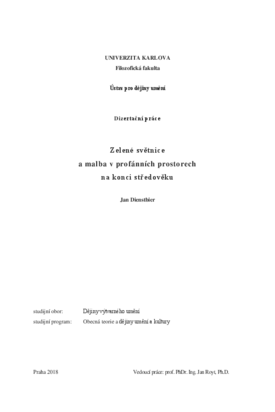Zelené světnice a malba v profánních prostorech na konci středověku
Green Chambers and Mural Painting in Secular Spaces at the End of the Middle Ages
dizertační práce (OBHÁJENO)

Zobrazit/
Trvalý odkaz
http://hdl.handle.net/20.500.11956/103695Identifikátory
SIS: 104906
Kolekce
- Kvalifikační práce [24991]
Autor
Vedoucí práce
Oponent práce
Jakubec, Ondřej
Gerát, Ivan
Fakulta / součást
Filozofická fakulta
Obor
Dějiny výtvarného umění
Katedra / ústav / klinika
Ústav pro dějiny umění
Datum obhajoby
19. 9. 2018
Nakladatel
Univerzita Karlova, Filozofická fakultaJazyk
Čeština
Známka
Prospěl/a
Klíčová slova (česky)
nástěnná malba|lov|turnaj|středověk|šlechta|moc žen|pomíjivost|ikonologie|Baba a čert|gender|epithalamický programKlíčová slova (anglicky)
mural painting|hunt|tournament|middle ages|nobility|power of women|transiency|iconology|Old woman as troublemaker|gender|epithalamic programPráce přináší podrobnou analýzu pozdně středověkých nástěnných maleb v tzv. zelené světnici na hradě Žirovnice a dalších podobných pozdně středověkých komplexech nástěnných maleb. Oproti starší literatuře práce akcentuje vzájemné ikonografické souvislosti výjevů zobrazených na jednotlivých stěnách žirovnického sálu: výjevů Paridova soudu, Judity stínající Holoferna, exempla Bába je horší než čert i obrazu dříve považovaného za Šalamounův soud (patrně podobenství o manželském a nemanželském dítěti). Ty na základě komparacích spojuje s podobnými vyobrazeními v zahraničí i jejich zpracováním v soudobé literatuře. Podrobně přitom ukazuje jejich spojitost s dobově oblíbeným konceptem kritiky moci žen (Weibermacht). Tento byl podobně jako jinde také na Žirovnici spojen s alegorií prchavosti lásky a pomíjivosti vůbec. V tomto smyslu pak práce interpretuje i i zdánlivě žánrová vyobrazení lovu a turnaje, k čemuž ukazuje celá řada detailů, které subverzivně převracejí jejich význam. Práce dále přináší srovnání Žirovnice s dalšími obdobnými památkami v Čechách a na Moravě a zamýšlí se nad jejich funkcí. Zároveň se zabývá problematikou uměleckohistorického fenoménu zelených světnic, k jehož prosazení ve středoevropském kontextu významně přispěl český historik umění Josef Krása. Práci je předeslán obsáhlý...
The thesis presents a detailed analysis of the late medieval murals in the so-called 'green chamber' of Žirovnice Castle and similar late-medieval mural paintings. Compared to the earlier literature the study focuses on the interrelations between the scenes depicted in the 'green chamber': the Judgement of Paris, Judith beheading Holofernes, the exemplum An Old Woman Is Worse than the Devil as well as an image which was previously described as the Judgement of Solomon (perhaps rather a parable about legitimate and illegitimate progeny). They are compared with other depictions of these themes and their treatment in contemporary literature. These comparisons link them with the popular concept of a critique of the power of women (Weibermacht). In Žirovnice, and similarly elsewhere, this concept was connected to the allegory of the transcience of love and the ephemeral nature of the world overall. The ostensible genre depictions of the hunt and tournament can be interpreted in this sense as well. This is demonstrated by numerous details subverting the meaning of these images. The study then compares Žirovnice to other similar murals in Bohemia and addresses the questions of their function as well as of the art-historical phenomenon of 'green chambers' as various secular murals are called following the...
